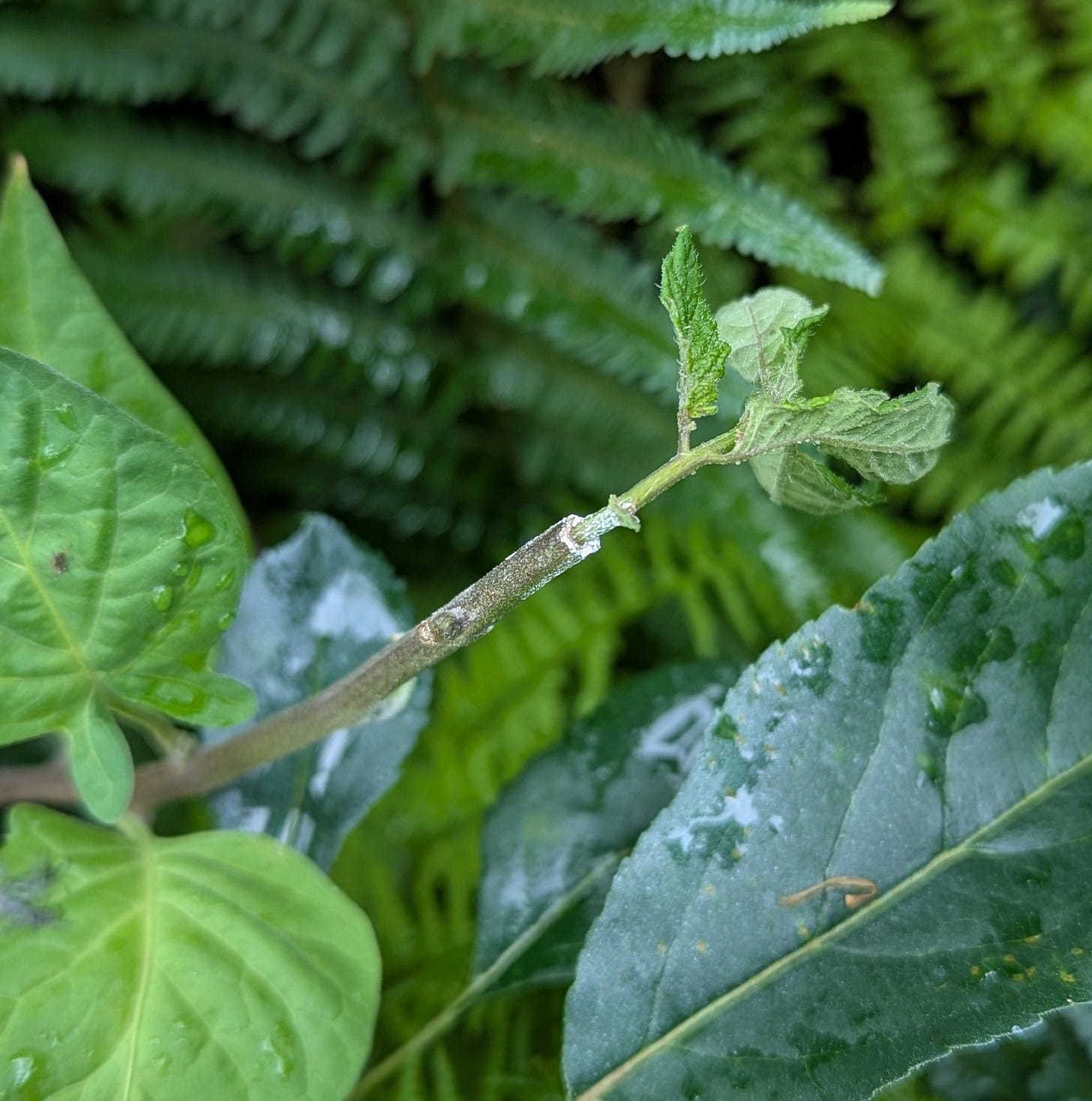Do your own research. Do not eat anything I mention in this article without doing your own research. I am not responsible for what you consume or use.
Ever since I fell down the plant breeding rabbit hole, I’ve had a love-hate relationship with Solanaceae. Whilst I admire the dedication tomato breeders bring to the craft, I think it can act like a giant tomato shaped black hole, sucking all breeding into its gravitational pull.
Having said that, last year a peculiar vining plant showed up next to my apple tree. I let it grow on and was surprised by beautiful sprays of purple flowers. There was something familiar about this flower, and I quickly walked over to a flowering volunteer potato plant in my compost heap. The connection was becoming clearer.
I pulled out iNaturalist and quickly learned that this was Bittersweet Nightshade, Solanum dulcamara.
As you might know, potatoes (Solanum tuberosum), tomatoes (Solanum lycopersicum), aubergine (Solanum melongena) and peppers (Capsicum sp.) all belong to the Nightshade (Solanaceae) family. They have the dubious honour of being on the right side of humanity, as in, they won’t kill you if you eat them (in the right way!).
Unfortunately, in cold temperate regions of the world (like the British Isles that yours truly inhabits), none of them can overwinter.
Thus we can return to Bittersweet Nightshade. This thing happily survived through our winter and has just started throwing out those beautiful purple flowers again. Some people claim that Solanum dulcamara has edible berries when fully ripe but I have not dared so far.
Last week, I decided to field graft a tomato to a bittersweet vine. I walked away and forgot about it until this morning. I think the graft might have taken but I will think very carefully if any fruit are borne!
Staring at this moonshot graft, I decided to draw up a list of members of the Solanaceae family that are cold temperate perennials in this soggy climate for fun and science. I’m focusing on species that easily sourced in the UK, so you might have a chance to create your very own Nightshade Garden (no, not Night Garden). I’ll group them by plant form as I think this highlights their variety.
Tree-form Nightshades
Lycium barbarum & L. chinense
Yes, the Goji trees are in the nightshade family. The Chinese have published research on grafting tomatoes to Goji rootstock to take advantage of their salt tolerance. Goji berries have become a “superfood” recently, but the leaves are a decent addition to your salads and stews. I have a 5 year old Goji tree that started off as a branch from a Oriental Supermarket, they root very easily.
Vining-form Nightshades
Solanum dulcamara
Bittersweet Nightshade can apparently volunteer randomly in your garden. If you pay attention, they are an uncommon hedgerow denizen too. Personally, I love how it climbs up nearby plants and forms a robust woody stem unlike its faint-hearted tomato cousin. The berries go from green, to yellow-orange, to red when ripened
Solanum crispum
The Potato tree is a new one to me, but the RHS love it so much a specific cultivar was awarded the “Garden Merit”. They apparently grow like Bittersweet Nightshade but the light purple flowers give way to white berries instead of red.
Bush-type Nightshades
Alkekengi officinarum
An extremely hardy cousin to the physalis (Physalis peruviana) that can sometimes be purchased in the exotic section of British supermarkets. Like the physalis, the fruit are borne in cage-like husks of petals. Tolerating temperatures down to -20°C, it was kept several hundred years ago in medicinal gardens where they are still found living feral. They are the Nightshade’s answer to mint.
Atropa bella-donna
Deadly Nightshade doesn’t need an introduction. One of the party stories I tell is apocryphal (only because I can’t find the source anymore); about a farmer who grafted tomato onto Atropa bella-donnna and made a meal with the super vigorous tomatoes that ultimately killed his family. I wasn’t aware that it was perennial in the UK.
Mandragora autumnalis
Mandrakes in general have a fascinating mythology, the most widely recalled one being their death-inducing scream when pulled from the ground. Mandrakes in general have huge genetic variety. Some people classify the autumn Mandrake as separate to Mandragora officinarum. In either case, sufficient quantities of the root extract were once used to knock people out for surgery!
Final Thoughts
If you can think of any more tree-form Nightshades, please let me know. I’m pretty sure that Lycium barbarum and L. chinense are the only two that thrive outdoors in the UK.
There are a few more vining Nightshades and definitely more bushy Nightshades, but the ones I’ve listed are the most easily purchased (either as seed or plant).
All these Solanaceae survive British winters easily. Unfortunately, only the Goji tree is also good to eat.
Until next time.
Further Reading
“Mason had grafted a tomato plant to a Jimson-weed plant.”
Jimson-weed being Datura stramonium: “An individual seed contains about 0.1 mg of atropine, and the approximate fatal dose for adult humans is >10 mg atropine”
Some of my notes on “field grafting”






This is great! You do the most interesting experiments. Have you grown Tamarillo? We called them tree tomatoes and had them in our garden in a colder region of India.